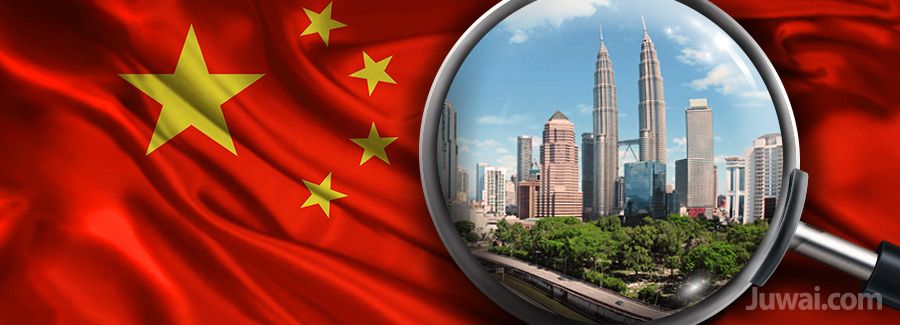Asia News
- Home
- News
- Asia News
You've successfully copied this link.
Here's why Malaysian property is on the rise with Chinese

550% – that’s how much Chinese buyer enquiries for Malaysian properties surged on Juwai.com in August 2016.
Following the MH370 flight disaster in 2014 that saw a sharp decline in Chinese arrivals, the Malaysian government has ramped up efforts to woo Chinese visitors.
From offering visa-free entry for Chinese from early 2016 till end 2017, to launching an e-visa programme, the Malaysian government has even signed a memorandum of understanding (MoU) with Alibaba to market Malaysian tourism products/services to Chinese consumers on its e-commerce platform.1
This strategy has worked, seeing as Chinese travellers and property hunters are now returning in droves, and Malaysia is once again a rising hotspot in the eyes of Chinese property hunters.
Ranked as the eleventh most popular Chinese property investment destination on Juwai.com for 1H 2016, Chinese buyers are increasingly warming up to Malaysia. We take a look at its appeal against its two more popular neighbours, Singapore and Thailand below:
#1 Strong growth potential
Malaysian property market offers significant growth potential that stems from strong economic fundamentals and demographic factors, which offers plenty of opportunities for Chinese property investors.2
This is especially true in its capital city of Kuala Lumpur, where robust business activities and availability of resources make it an ideal city for start-ups, as well as the city of Johor Bahru, which is just across from Singapore.
Strong foreign ownership level and a liberalisation of its foreign investment policies are additional reasons propelling both Chinese buyers and developers to Malaysia.
Malaysia allows foreign buyers to own freehold properties or those with leasehold titles of 99 years.
#2 Cultural connections thanks to large Chinese community
Malaysia is a multiracial country, and like neighbouring Singapore, Malaysia is home to a large China diaspora, which ranks as the world’s second-biggest overseas Chinese community after Thailand.3
Malaysian Chinese account for 23.4% of Malaysia’s population of 31.7 million, the second-largest ethnic group, behind Malays (68.6%) and ahead of Indians (7.0%), Others (1.0%), and non-Malaysian citizens (10.3%).4
Today, the Chinese community in Malaysia is a melting pot of various Chinese subgroups that brought along their respective cultures and dialects, including Mandarin, Hokkien, Cantonese, Hakka, Teochew, and Hainanese.5
Such similarities in both culture and language – especially when compared to neighbouring nations, such as Thailand, Vietnam, and Indonesia – make Malaysia a desirable pick for Chinese buyers.
#3 Easy foreign residency scheme
Malaysia offers a foreign residency scheme called ‘Malaysia My Second Home’ (MM2H), which not only is relatively easier to get into when compared to similar schemes elsewhere in the world, but is also the cheapest within the region.6
For example, the EB-5 investor immigration programme in the US requires foreigners to invest either a minimum of $1 million in a commercial enterprise or $500,000 within Targeted Employment Area (High Unemployment or Rural Area) and create/preserve 10 full-time jobs for qualifying American employees within a two-year period to qualify.7
In Malaysia though, all they need is liquid assets of minimum RM500,000 ($112,550) for those aged under 50, while those above the age of 50 only require liquid assets of RM350,000 ($787,85) to be eligible for a 10-year multiple entry visa with indefinite renewals for multiple family members!8
When put this way, it’s not hard to understand why Malaysia has risen to become an alternative emigration destination for both China’s wealthy and middle-class population.
Liked this story? Find out more reasons driving Chinese property investors to Malaysia in our Juwai Southeast Asia Chinese Property Report!
Sources: 1. Oxford Business Group: Malaysia looks to attract more Chinese tourists; 2. Bloomberg: China’s R&F pays $1.4 billion for Malaysia land in expansion; 3. China Whisper: 6 places with strong Chinese communities outside mainland China; 4. Department of Statistics Malaysia, Offical Portal: Current Population Estimates, 2014-2016; 5. SAYS: The origins of the Hokkien, Cantonese, and other Chinese dialect groups in Malaysia; 6. Quartz: Why Chinese families will keep moving to Malaysia despite their anger over MH370; 7. U.S. Citizenship and Immigration Services: About the EB-5 Visa; 8. Official Portal Malaysia My Second Home Program
Liked this article? Sign up for free to get Juwai Juwai Asia Market updates!
Sort By
- 2025
- 2023
- 2022
- 2021
- 2020
- 2019
- 2018
- 2017
- 2016
- 2015
- 2014
- 2013
- 2012
Tags
- australia
- china
- chinese buyers
- investment
- juwai
- property
- real estate
- residential
- united kingdom
- united states
Resources
Our Property Marketplaces
Juwai.com >
Global property portal available in Chinese
Juwai.asia >
Asia wide portal for global real estate
Juwai News
Subscribe to receive the latest news on Asian buyers, the Asia market, and Juwai.
Thank you for subscribing to Juwai News!
Sign up for a Juwai Account now for free to enjoy FREE download access to country-specific reports on Chinese property investments.
Do you want to sign up now? Or continue if you have already signed up or you will do it later.
Thank you!
You’ve just subscribed to get updates
to the Chinese Buyer Tips blog by email.
2025 © Juwai. All Rights Reserved Privacy Policy | Terms of Service


